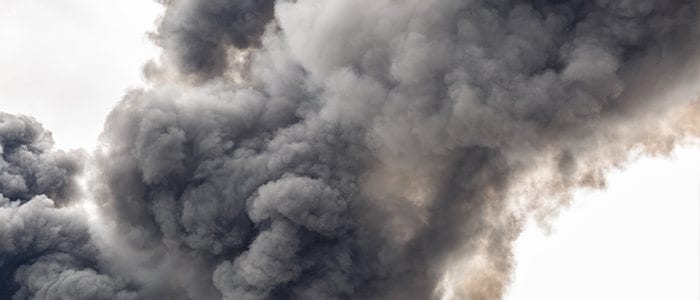Environmental Threats to Your Data Center
Environmental threats are a common contributor to equipment failure and data center down time. For example, in August of 2016, Delta Airlines experienced electrical problems and a fire in their data center that led to nationwide flight cancellations and significant lost revenue. When evaluating data center operations consider environmental risks and their potential impact on availability.
Common Environmental Threats
Fires
- Fires are responsible for about 6% of data center downtime and can be caused by heavy power loads, shorts due to contaminants, or defective components. Smoke, ash, water, and chemical byproducts can all cause serious equipment issues even when the fire is quickly contained.
Contaminants
- Data center contaminants come from a wide variety of sources both inside and outside the data center.
- Interior contaminants include lint from clothing, skin particles, hair, fibers, packing materials, gases, electrostatic dust, metal filaments, paper and toner dust, fan belt wear in air handling units, cleaning materials, etc.
- External contaminants include pollution, pollen, sea salt, construction dust, exhaust, etc.
Temperature
- Temperature is a significant factor in maintaining the proper environmental conditions in a data center, particularly in the context of energy consumption and cost. Higher temperatures lead to increased fan power consumption and air flow requirements. Economizers like Vertiv’s DSE Free Cooling System increase efficiency and may broaden the acceptable data center temperature range.
Moisture and Humidity
- Moisture, humidity are major concerns for data center managers.
- High humidity may lead to moisture settling on computer equipment which causes corrosion and component failure.
- Low humidity leads to electrostatic discharge (ESD) which can damage or destroy sensitive electronics.
Power Failure
- Businesses have a 30 percent probability of experiencing power quality problems if their facility is more than five years old and has undergone significant changes. Threats from power anomalies not only include device electrical failures, and facility power issues but external threats such as lightening.
How do environmental threats impact your IT equipment?
From reduced performance, to intermittent, or complete component failure, environmental threats impact technology in several ways:
- Physical Interference: Particles can remove material from the surface of the component by grinding or embedding.
- Corrosive Failure: Particles can absorb water and gaseous contaminants which can interfere with mechanisms or cause damage by forming salt solutions.
- UPS Battery Failure: Approximately 37% of UPS failures are battery-related. While a UPS will continue to operate in varying temperatures, higher temperatures will likely result in diminished performance and battery life.
- Electrical Shorts: Electrical shorts can lead to intermittent failures as well as component damage.
- Thermal Failure: Clogging of filtering devices, for example server components clogged with dust, can cause fan failures and result in overheating.
- Data Corruption: Hard drive moving parts may degrade over time and when they fail data may be corrupted, or lost.
- Reduced Efficiency: In addition to downtime, environmental issues can reduce data center efficiency. For example, dirty filters reduce air flow and cooling system efficiency.
What is Environmental Monitoring?
Environmental monitoring can help protect your data center from environmental threats. Remote monitoring solutions track environmental conditions such as temperature, humidity, motion, battery life, contaminants, and more.
The benefits of monitoring solutions include:
- Integration with other alarm systems such as smoke detectors, vibration sensors, water leak detectors etc.
- Detection of changes within the monitored environment
- Alert notifications based on defined communications and emergency procedures
- Enable built in responses, for example shutting down a system that is overheated
- Provide trend information to prevent future issues
Contact Us
As your local Vertiv partner, we offer monitoring solutions, data center assessment, award winning products, and expertise that will save your business time and money. Contact us today to learn more about protecting your data center from environmental threats.

